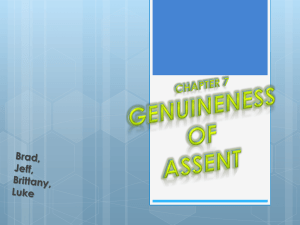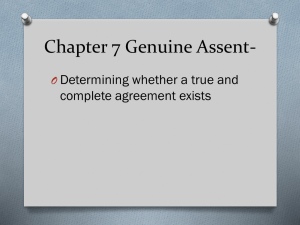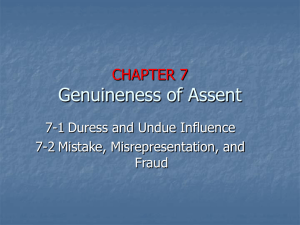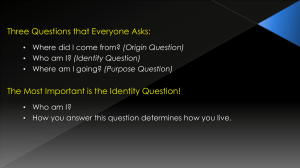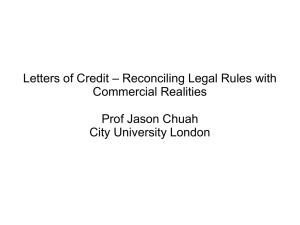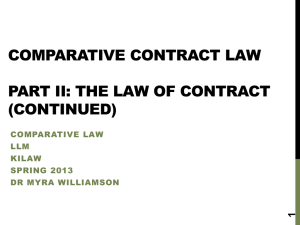Seminar Presentation - Allen & Overy Seminars > What`s new?
advertisement
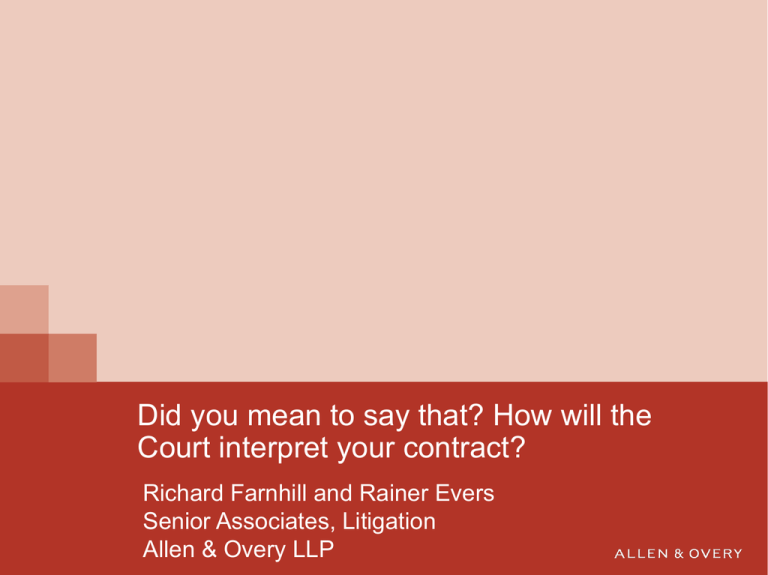
Did you mean to say that? How will the Court interpret your contract? Richard Farnhill and Rainer Evers Senior Associates, Litigation Allen & Overy LLP Overview The terms of the contract Express Implied – to be covered in the next talk Express terms Why are they important? How do you locate them? How you interpret them in theory? Intention, Interpretation and Construction in practice LT: 3933761 Why are they important? Necessary for the contract to be formed "If parties have shown an intention to be contractually committed… then the court will recognise a contract unless what remains outstanding is not merely important but essential in the sense that without it the contract is too uncertain or incomplete to be enforced." Bear Stearns Bank plc v Forum Global Equity Ltd at para 155 Necessary to define the obligations LT: 3933761 Why are they important? Necessary to define the recovery for any breach "In [the case of express and implied terms], the consequences for which the contracting party will be liable are those which “the law regards as best giving effect to the express obligations assumed” and “[not] extending them so as to impose on the [contracting party] a liability greater than he could reasonably have thought he was undertaking”." Transfield Shipping Inc v Mercator Shipping Inc [2008] 3 WLR 345 per Lord Hoffmann at para 16 LT: 3933761 How do you locate them? Incorporation By signature By reference By course of dealing The pitfalls Suites of agreements Part oral – part written agreements LT: 3933761 How you interpret them? As object – to ascertain the intention of the parties To be objectively assessed Words to be given their ordinary and natural meaning Assessed against the “factual matrix” But is that Imputed knowledge – “Subject to the requirement that it should have been reasonably available to the parties … it includes absolutely anything which would have affected the way in which the language of the document would have been understood by a reasonable man.” ICS v West Bromwich [1998] 1 WLR 896 per Lord Hoffmann at 912-913 LT: 3933761 How do you interpret them? Or actual knowledge “…all the relevant facts surrounding the transaction so far as known to the parties.” BCCI v Ali (No 1) [2002] 1 AC 251 per Lord Bingham at 259 In either case, communication is key LT: 3933761 The Search for Meaning “Somewhere between the writer and the reader The meaning floats” Roger McGough “dans la langue il n’y a que des differences sans termes positifs” Ferndinand de Saussure “Interpretation creates intent” “The imperfection of human language renders it… absolutely impossible to define the word ‘building’” Byles J Stevens v Gourley (1859) 7 CBNS LT: 3933761 Construction + Intent 1 “Rules of construction are… merely guidelines to the presumed intention of the parties in the light of events which have occurred.” Kerr LJ Mitchell v Finney Stock Seeds [1983] QB Intention is approached objectively; courts have no access to private thoughts, negotiators may be dead, intentions can be misremembered, contract may be inherited by new parties. “One must consider the meaning of the words used, not what one may guess to be the intention of the parties” Jessel MR Smith v Lucas [1881] 18 ChD LT: 3933761 Construction + Intent 2 Construction aims at effectuating “the intention of the parties, to be collected from the whole of the agreement” Ford v Beech [1848] 11 QB “every portion of a document must be fully considered ere any portion of such document be interpreted” McCardie J SS Magnhild v McIntyre Bros [1920] 3 KB If “a particular construction leads to a very unreasonable result [that] must be a relevant consideration. The more unreasonable the result, the more unlikely it is that the parties can have intended it, and if they do intend it, the more necessary it is that they shall make that intention abundantly clear.” Lord Reid Schuler (L) v Wickman Machine Tool Sales [1974] AC LT: 3933761 Construction + Intent 3 If ambiguous/more than one construction, take one which saves the contract rather than one which makes it void, even if it is linguistically less likely – see Simon Brown LJ in Lancashire CC v Municipal Insurance [1996] 2 All ER. Words or conduct after formation are irrelevant: “is it not legitimate to use as an aid in construction… anything which the parties did or said after it was made.” Lord Reid James Miller & Partners v Whitworth Street Estates [1970] 2 AC “it is to be presumed that it was not the intention of the parties that either party should be entitled to rely upon his own breaches of his primary obligations as bringing the contract to an end” or to get a benefit under it. Lord Diplock Cheall v Apex [1983] 2 AC LT: 3933761 Construction + Intent 4 Contracts are formed in a legal context: “the law being well settled, when you have a contract of that kind you apply the understood law, and you hold that the parties, knowing what the law was” intended a partnership. Cairns LC Llanelli Railway v London & NW Railway [1875] 1 App Cas. “once a phrase has been authoritatively construed by a court in a very similar context… a reasonable businessman must more naturally be taken to [intend] that the phrase should bear the same meaning… It would… take very clear words to allow a court to construe the phrase differently” Waller LJ British Sugar v NEI Power Projects [1997] 87 BLR Starting with assumed purpose, and reading the words in the light of that purpose, is circular. “questions of construction are frequently matters of impression and are not readily susceptible of precise explanation”. Walker LJ Welsh v Greenwich LBC [2001] 81 P & CR LT: 3933761 Being told what you meant: Entire Agreement Clauses (i) Thomas Witter v TBP Industries [1994] Tr. L.R: exclusion for misrepresentation unreasonable as it didn’t say exclusion did not apply to fraudulent misrepresentation, and would not be reasonable to exclude liability for fraud: “if a clause is to have the effect of excluding or reducing remedies for damaging untrue statements, then the party seeking that protection cannot be mealy-mouthed in his clause” “I cannot think it is reasonable to exclude liability for fraudulent misrepresentation” Jacob J. Fell foul of s3 of Misrepresentation Act 1967, requiring exclusion for misrepresentation to satisfy reasonableness test in s11 UCTA 1977. Clause did not distinguish between fraudulent, negligent and innocent misrepresentation and was struck out entirely: “It is not for the law to fudge a way for an exclusion clause to be valid” Jacob J. LT: 3933761 Being told what you meant: Entire Agreement Clauses (ii) “it is reasonable to assume… the parties desire commercial certainty. They want to order their affairs on the basis that the bargain between them can be found within the document which they have signed. They want to avoid the uncertainty of litigation based on allegations as to the content of oral discussions at pre-contractual meetings… it is reasonable to assume that the price to be paid reflects the commercial risk which each party… is willing to accept [in this instance] it would be bizarre… to attribute to them an intention to exclude a liability which they must have thought could never arise.” Chadwick LJ Watford Electronics v Sanderson CFL [2001] EWCA Civ 317 Peart Stevenson Associates v Brian Holland [2008] EWHC (QB), Judge Richard Seymour QC held non-reliance clause unenforceable against fraudulent misrepresentation, but did not say if this was because clause failed to create an estoppel, preventing claimant from saying a misrepresentation had been made, or because exclusion was unreasonable. Why should parties find it unreasonable to exclude liability for fraud? On LJ Chadwick’s analysis, this would be part of risk-allocation. LT: 3933761 Being told what you meant: Settlement Agreements and Future Claims BCCI v Ali [2001] UKHL 8: claimant could not have renounced right to bring future claims if he did not know he had the right to bring them, unless agreement specifically stated this. “a long and… salutary line of authority shows that, in the absence of clear language, the court will be very slow to infer that a party intended to surrender rights and claims of which he was unaware and could not have been aware.” Lord Bingham Court is inferring intention, but not from the contractual language. In Ali, Lord Hoffmann said, of his reference to the background which may be taken into account in ICS, that: “I was… saying that there is no conceptual limit to what can be regarded as background.” With disarming candour, he also noted that: “When judges say that ‘in the absence of clear words’ they would be unwilling to construe a document to mean something, they generally mean… that the effect of the document is unfair.” LT: 3933761 Being told what you meant: Settlement Agreements and Fraud Claims Satyam Computer Services v Upaid Systems [2008] All ER, Collins LJ, basing himself on Ali, stated: “the same principle must apply to claims based on fraud… express words would be necessary for such a release” “If a party seeking a release asked the other party to confirm that it would apply to claims based on fraud, it would not, in most cases, be difficult to anticipate the answer.” Collins LJ has assumed intent. In fact, we often deal with settlements where the parties intend a release from claims based on fraud. Before Satyam, settlement agreements typically did not refer specifically to fraud. As “claim” in such agreements was often very widely drafted, the agreements arguably already covered fraud - judiciary has reversed its rules of construction by assuming parties’ intentions were not reflected in their words. LT: 3933761 Construing Settlement Agreements Evidence of intent by the back door? Tomlin v Standard Telephones [1967] 1 WLR, Court of Appeal admitted without prejudice correspondence in order to interpret a settlement agreement: “the point was whether there had been a concluded agreement of any kind between the parties in accordance with that correspondence and it would be impossible to decide [that]… unless one looked at the correspondence.” Danckwerts LJ How far this stretches is unclear. Tomlin says you can admit without prejudice evidence to show there was an agreement, but not whether such material can be used to show its content. Once agreement has been found, its meaning in terms of e.g. releases from claims based on fraud, is now settled by judicial dicta, not by evidence about intent. LT: 3933761 Construction today “(i)… in construing the contract, the court must look at the circumstances surrounding its making in order to see what was the objective that the parties had in view; (ii)… a prior agreement is at least admissible as a guide to construction; and… (iii) the following are inadmissible (a) the content of prior negotiations; (b) communications between the insured and its broker which were not communicated to the reinsurers and (c) the subjective views of the parties as to what they thought they had achieved.” Clarke J Mopani Copper Mines v Millennium Underwriting [2008] EWHC 1331 LT: 3933761 How not to do it “X may at any time… assign…all or any of its rights and/or obligations… provided such assignment… is to its successors in title or to its ultimate parent company” “I would confirm that in return for your full cooperation with our investigations… we will not, based on the information currently available to us, bring claims against you in relation to fees received by you in respect of bona fide property transactions or compensation for loss of office” LT: 3933761 Questions? These are presentation slides only. The information within these slides does not constitute definitive advice and should not be used as the basis for giving definitive advice without checking the primary sources. Allen & Overy means Allen & Overy LLP and/or its affiliated undertakings. The term partner is used to refer to a member of Allen & Overy LLP or an employee or consultant with equivalent standing and qualifications or an individual with equivalent status in one of Allen & Overy LLP's affiliated undertakings. LT: 3933761 New York CLE In order to comply with regulations for New York CLE, delegates must note the following code to claim hours under this jurisdiction if viewing this seminar by Video-Conference or DVD: LCET8972531 LT: 3933761
